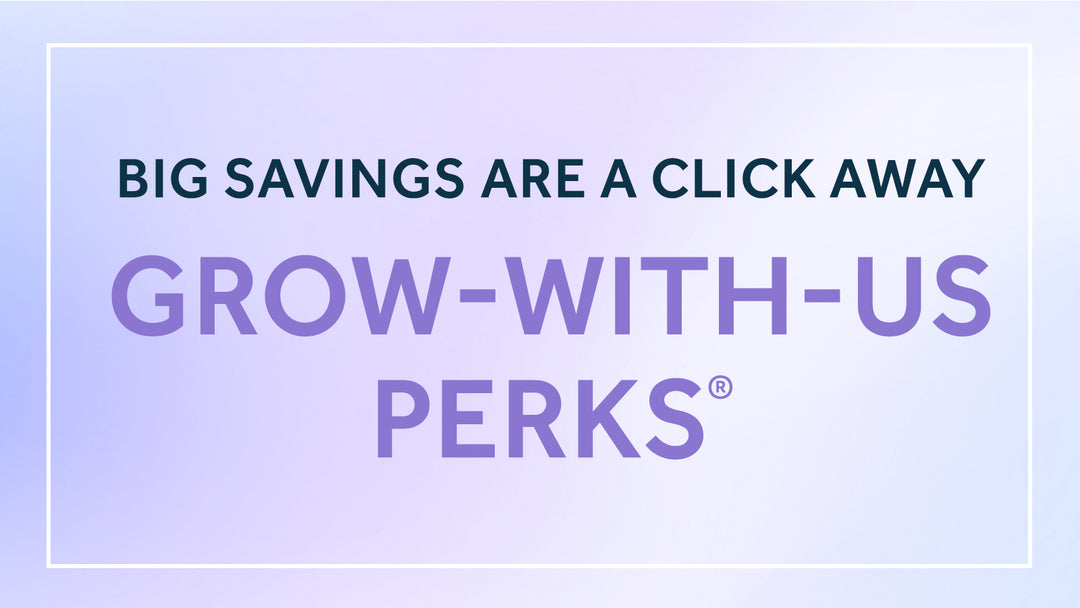The Ultimate Guide to Budgeting for Baby Clothes

One of the best parts about expecting a baby is getting to shop for adorable baby clothes. From teeny-tiny baby shoes to precious take-me-home sets, it can be difficult to stop yourself from buying all of the cute newborn outfits and accessories you come across. However, you may also be on a tight budget, which means you need to be a little more careful about where you spend your hard-earned dollars.
Baby clothes are a necessity, plain and simple. But if you don’t budget for baby clothes in advance, you could wind up spending far more than you intended to on your little one’s wardrobe. Luckily for you, we’ve made a simple guide to budgeting for baby clothes. Read on for our list of budgeting tips and tricks that can help you save big on your baby’s wardrobe essentials.

Why Budget for Baby Clothes?
The cost of baby clothes may seem like a drop in the bucket compared to nursery furniture and other big-ticket items. But don’t be fooled—those pint-sized outfits can add up quickly! If you’re tight on cash, here’s why budgeting for baby clothes is a good idea:
- It Keeps Your Spending Habits in Check – When you aren’t consciously budgeting for baby clothes, it’s all too easy to buy every adorable baby item on the spot. Keeping track of your expenses and budgeting for your baby in advance helps you avoid buying more baby clothes than you actually need.
- It Allows You to Shop Without Stress – Shopping for your baby is a lot more fun when you aren’t constantly stressing about your finances. With a budget in place, you can easily see how much “play money” you have to spend on baby clothes and can proceed to shop guilt-free.
- It Helps You Make the Most of Baby’s Wardrobe – Since newborn babies grow incredibly fast, it’s important for new parents to be strategic with their baby’s wardrobe. As adorable as newborn clothes are, those tiny clothes are quickly outgrown. In fact, larger babies may not fit into newborn sizes at all! With a few smart budgeting tips, you can get more mileage out of your baby’s wardrobe.
The Cost of Baby Clothing
According to Investopedia, the average cost of baby clothes is about $60 per month for a baby’s first year of life. Keep in mind that this amount is strongly correlated with income. If money is tight and you’re planning to live off a single income, you may end up spending half that amount. If you have a high income, you might spend that amount on a single outfit for your little one.
It’s worth pointing out that where you live can also impact how much you spend on baby clothes. High-end baby clothes are more popular (and more expensive) in urban areas than they are in rural areas, so you may end up spending more if you live in a big city. Additionally, weather can play a role in your baby’s clothing budget because babies in cold-weather regions usually need more clothing (bunting bag, snow boots, etc.) to keep them warm.
Budgeting for Baby: 11 Tips to Help You Save on Baby Clothes
Babies definitely cost money, but their wardrobe doesn’t need to be outrageously expensive. Here are a few budgeting and money-saving tips to help you avoid overspending on baby clothing.
1. Make a Budget for Baby Clothes
The first step to budgeting for your baby is to decide how much you want to spend on baby clothes each month. To do this, you’ll need to take a closer look at your finances and figure out what you can reasonably afford.
Again, this amount will vary based on your income. No matter what spending limit you set, make sure that it’s realistic!
2. Create a List of Essential Baby Clothes
Now, it’s time to make a list of clothing essentials you’ll need for the baby. This can be tricky for soon-to-be parents because everything feels like a “must-have” when you’re pregnant with your first!
To start, stick with the bare minimum of what you’ll need. For example, you’ll definitely want to stock up on Onesies® Brand Bodysuits since your baby will practically be living in them throughout the newborn stage. Other essential clothing items for the baby include cozy sleepwear, wrap-front tops, pants, swaddles, hats and socks.
Once you have a shortlist of baby clothing essentials, make a separate list for “nice-to-have” items. This list could include items like fancy dresses for baby photoshoots, adorable holiday outfits or even an expensive outfit that you may decide to splurge on later (assuming it works with your budget).
3. Wait to Buy Newborn Clothing
If (or when) you decide to find out the sex of your baby early, you may be tempted to go on a shopping spree for newborn clothes. Try to hold off! For one thing, your baby may be born larger than average and never fit into newborn size clothing.
Another reason why you should hold off on buying newborn clothes is because you’ll probably get a truckload of newborn clothing whether you ask for them or not. Friends and family just can’t seem to resist the allure of teeny-tiny baby clothes! To make the most of your budget, consider waiting until after your baby shower to buy all those cute newborn clothes you’ve been eyeing.
4. Think Ahead with Your Baby Registry
Speaking of baby registries, let’s talk about yours! To make the most of your baby registry and your budget, it’s important to think ahead when registering for baby clothes. Newborns grow incredibly fast and come in many different shapes and sizes. For these reasons, it’s best to register for a range of clothing sizes that your baby can wear as they grow.
Since babies grow in the blink of an eye, we recommend adding our Grow-With-Me-Sets to your baby registry. These practical bundles include Onesies® Brand Bodysuits in a variety of sizes to ensure that your baby is covered throughout their infancy.
If you ever find yourself struggling to choose the right clothing size for your newborn, play it safe by sizing up. As long as baby’s clothes aren’t too baggy on them, you can usually roll up the sleeves and let your baby grow into them.

5. Choose Well-Made Baby Clothes
Your baby may not need designer outfits or fancy clothes, but it’s definitely worth investing in well-made baby clothes for your little one. Tiny babies often make big messes, so it’s important to choose quality baby clothes that will hold up through frequent washings.
When shopping for baby clothes, keep comfort and ease in mind. Choose super-soft baby clothes that are designed for easy changing. If you’re looking for baby clothes made from the best materials, organic baby clothes—like those from Gerber’s organic clothing collection—are a great option because they’re free of harsh dyes and chemicals.
New parents should also look for durable baby clothing that can handle spit-up and diaper blowouts. Note: This tip applies to baby bibs and burp cloths, too! Stock up on bibs and burp cloths that will help protect clothes (both yours and baby’s) from messes.
6. Supplement Baby’s Wardrobe with Hand-Me-Down Items
As a first-time parent, you may prefer to stock your baby’s wardrobe with all-new clothes—and that’s completely understandable! We all want to give our babies the best items we can. Buying long-lasting baby clothing can even save you money down the line if you decide to have another baby. If you buy high-quality clothes for your first child, you can get lots of re-wear in sizes 0-6, especially if you bought gender-neutral colors and prints.
On a similar note, don’t be shy about accepting hand-me-downs from your mommy friends. Most people are more than happy to get rid of baby clothes they’re no longer using, especially if it means helping out a soon-to-be parent!

7. Buy Gender-Neutral Baby Clothing
Thinking about having more kids in the future? If so, consider stocking up on gender-neutral baby clothes for your little one. Unlike traditional blues and pinks, gender-neutral colors such as yellow, gray and green are much more reusable. Gender-neutral baby clothes are also trendy right now, so you should have plenty of options for your sweet pea.
If you don’t want your baby’s closet to be entirely gender-neutral, consider saving the neutral hues for splurge items only. That way, your next kiddo can reuse their older sibling’s fancy spring jacket or expensive jumpsuit, regardless of their gender.
8. Return Baby Shower Items You Don’t Need
No matter how much you try to encourage people to stick to your baby registry, there’s a good chance that you’ll end up with lots of stuff you don’t need. Hang on to the receipts! You can usually return your duplicate items in exchange for store credit, which allows you to buy baby clothes that you actually need.
Although it can be frustrating when friends and family ignore your baby registry, try to remember that their hearts are in the right place. Write a sincere thank you note to the gift-giver and quietly return the unwanted items. Then, turn around and buy what you really need for your baby.
9. Consider Cloth Diapers
Whether you have a separate budget for diapering or not, it’s worth talking about cloth diapering for your little one. Choosing cloth diapers offers many benefits to new parents, one of which is the potential to save lots of money.
According to the Bump, families typically spend between $2,000 and $3,000 on disposable diapers over the course of two years—and that’s just for one baby. Cloth diapers are reusable, which is better for both the environment and your wallet.
Most importantly, cloth diapers are better for your little one’s health. Unlike disposable diapers, cloth diapers are generally free from potentially harmful chemicals such as dioxins, phthalates, dyes and fragrances. Besides, ditching disposables is easier than you might think. Check out our beginner’s guide to cloth diapering to learn more or start shopping for cloth diapers at Gerber Childrenswear.

10. Take Advantage of Doorbuster Deals
Want to dress your baby in the best outfits without going over-budget? Wait for the perfect time to buy. Gerber Childrenswear and other beloved baby clothing brands regularly hold promotions and sales that can help you score well-made baby clothes for low prices. To stay in the know, be sure to sign up for our email newsletter and get alerted for doorbuster deals.
11. Take Good Care of the Baby’s Clothing
Knowing how to take good care of your baby’s clothes is essential—not just from a financial standpoint, but also for your little one’s health. Many laundry detergents on the market aren’t safe for baby’s sensitive skin and can lead to increased wear and tear on baby’s clothes.
To make the most of your baby’s wardrobe, know how to clean and launder baby clothes effectively. Choose a laundry detergent that is specifically made for washing baby clothes. Also, be sure to read the laundering instructions on the garment’s label carefully before you throw them in the wash. And if your baby’s clothes get stained, try to treat the stain as quickly as possible!
Don’t let financial stress take away the joy and excitement of shopping for your bundle of joy. With these smart budgeting tips, you can dress your baby in the best clothes without breaking the bank.
Ready to start shopping for your baby? At Gerber Childrenswear, we make it easy to find quality baby clothes at prices you’ll love. Browse our selection of baby clothes and essentials today!
SHOP NOWImage Sources
memej / Shutterstock.com


















